The Bulldozer Review: AMD FX-8150 Tested
by Anand Lal Shimpi on October 12, 2011 1:27 AM ESTPower Management and Real Turbo Core
Like Llano, Bulldozer incorporates significant clock and power gating throughout its design. Power gating allows individual idle cores to be almost completely powered down, opening up headroom for active cores to be throttled up above and beyond their base operating frequency. Intel's calls this dynamic clock speed adjustment Turbo Boost, while AMD refers to it as Turbo Core.
The Phenom II X6 featured a rudimentary version of Turbo Core without any power gating. As a result, Turbo Core was hardly active in those processors and when it was on, it didn't stay active for very long at all.
Bulldozer's Turbo Core is far more robust. While it still uses Llano's digital estimation method of determining power consumption (e.g. the CPU knows ALU operation x consumes y-watts of power), the results should be far more tangible than what we've seen from any high-end AMD processor in the past.
Turbo Core's granularity hasn't changed with the move to Bulldozer however. If half (or fewer) of the processor cores are active, max turbo is allowed. If any more cores are active, a lower turbo frequency can be selected. Those are the only two frequencies available above the base frequency.
AMD doesn't currently have a Turbo Core monitoring utility so we turned to Core Temp to record CPU frequency while running various workloads to measure the impact of Turbo Core on Bulldozer compared to Phenom II X6 and Sandy Bridge.
First let's pick a heavily threaded workload: our x264 HD benchmark. Each run of our x264 test is composed of two passes: a lightly threaded first pass that analyzes the video, and a heavily threaded second pass that performs the actual encode. Our test runs four times before outputting a result. I measured the frequency of Core 0 over the duration of the test.
Let's start with the Phenom II X6 1100T. By default the 1100T should run at 3.3GHz, but with half or fewer cores enabled it can turbo up to 3.7GHz. If Turbo Core is able to work, I'd expect to see some jumps up to 3.7GHz during the lightly threaded passes of our x264 test:
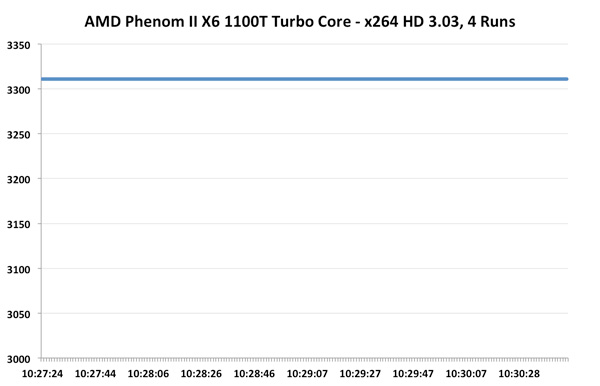
Unfortunately we see nothing of the sort. Turbo Core is pretty much non-functional on the Phenom II X6, at least running this workload. Average clock speed is a meager 3.31GHz, just barely above stock and likely only due to ASUS being aggressive with its clocking.
Now let's look at the FX-8150 with Turbo Core. The base clock here is 3.6GHz, max turbo is 4.2GHz and the intermediate turbo is 3.9GHz:
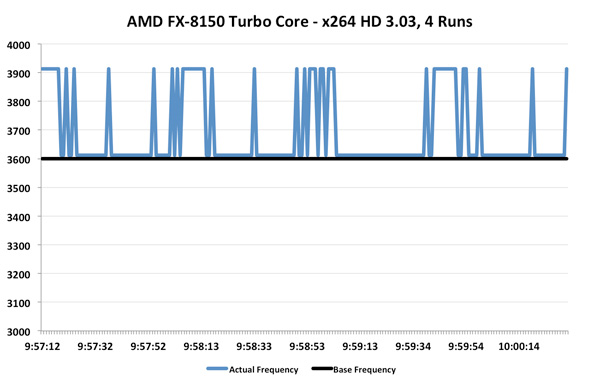
Ah that's more like it. While the average is only 3.69GHz (+2.5% over stock), we're actually seeing some movement here. This workload in particular is hard on any processor as you'll see from Intel's 2500K below:
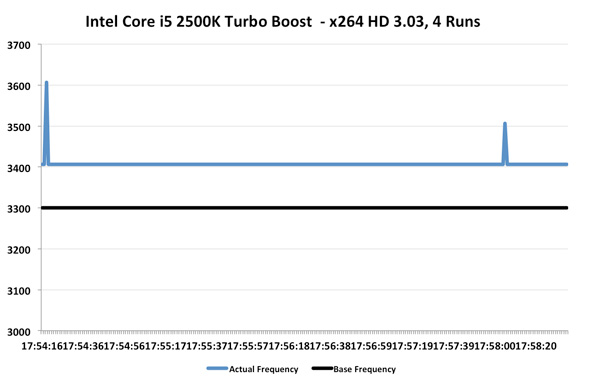
The 2500K runs at 3.3GHz by default, but thanks to turbo it averages 3.41GHz for the duration of this test. We even see a couple of jumps to 3.5 and 3.6GHz. Intel's turbo is a bit more consistent than AMD's, but average clock increase is quite similar at 3%.
Now let's look at the best case scenario for turbo: a heavy single threaded application. A single demanding application, even for a brief period of time, is really where these turbo modes can truly shine. Turbo helps launch applications quicker, make windows appear faster and make an easy time of churning through bursty workloads.
We turn to our usual favorite Cinebench 11.5, as it has an excellent single-threaded benchmark built in. Once again we start with the Phenom II X6 1100T:
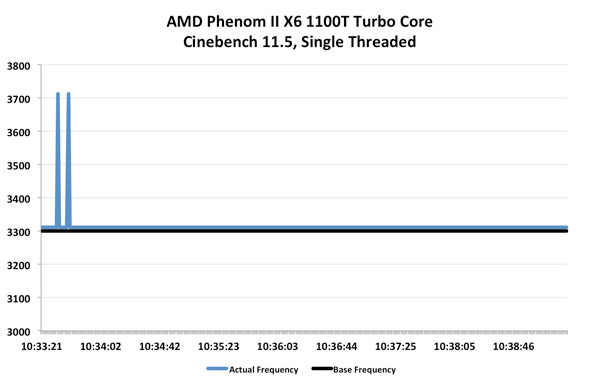
Turbo Core actually works on the Phenom II X6, albeit for a very short duration. We see a couple of blips up to 3.7GHz but the rest of the time the chip remains at 3.3GHz. Average clock speed is once again, 3.31GHz.
Bulldozer does far better:

Here we see blips up to 4.2GHz and pretty consistent performance at 3.9GHz, exactly what you'd expect. Average clock speed is 3.93GHz, a full 9% above the 3.6GHz base clock of the FX-8150.

Intel's turbo fluctuates much more frequently here, moving between 3.4GHz and 3.6GHz as it runs into TDP limits. The average clock speed remains at 3.5GHz, or a 6% increase over the base. For the first time ever, AMD actually does a better job at scaling frequency via turbo than Intel. While I would like to see more granular turbo options, it's clear that Turbo Core is a real feature in Bulldozer and not the half-hearted attempt we got with Phenom II X6. I measured the performance gains due to Turbo Core across a number of our benchmarks:

Average performance increased by just under 5% across our tests. It's nothing earth shattering, but it's a start. Don't forget how unassuming the first implementations of Turbo Boost were on Intel architectures. I do hope with future generations we may see even more significant gains from Turbo Core on Bulldozer derivatives.
Independent Clock Frequencies
When AMD introduced the original Phenom processor it promised more energy efficient execution by being able to clock each core independently. You could have a heavy workload running on Core 0 at 2.6GHz, while Core 3 ran a lighter thread at 1.6GHz. In practice, we felt Phenom's asynchronous clocking was a burden as the CPU/OS scheduler combination would sometimes take too long to ramp up a core to a higher frequency when needed. The result, at least back then, was that you'd get significantly lower performance in these workloads that shuffled threads from one core to the next. The problem was so bad that AMD abandoned asynchronous clocking altogether in Phenom II.
The feature is back in Bulldozer, and this time AMD believes it will be problem free. The first major change is with Windows 7, core parking should keep some threads from haphazardly dancing around all available cores. The second change is that Bulldozer can ramp frequencies up and down much quicker than the original Phenom ever could. Chalk that up to a side benefit of Turbo Core being a major part of the architecture this time around.
Asynchronous clocking in Bulldozer hasn't proven to be a burden in any of our tests thus far, however I'm reluctant to embrace it as an advantage just yet. At least not until we've had some more experience with the feature under our belts.


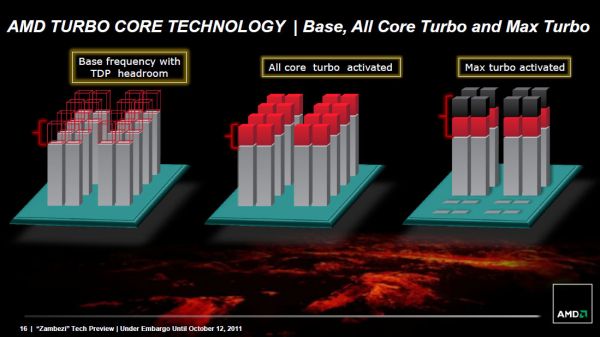








430 Comments
View All Comments
Gasaraki88 - Friday, October 21, 2011 - link
I think the main competitor for Intel in the future is going to be the ARM processor makers. As Intel goes in to that space with the x86 and the ARM chips getting faster and faster and Windows 8 supporting ARM, you get a mix and soon ARM chip will invade the desktop/laptop market.AMD is done.
ppro - Monday, October 24, 2011 - link
I decided to get this new cpu from www.amd.comnavair2 - Monday, October 24, 2011 - link
I decided to try AMD when I "inherited" my brother's older socket 939 hardware some years ago, then built my own using a Phenom II X4 940 BE.At the time it was released, the 940 wasn't too far behind the i7 920 in many respects, plus it was about $70 cheaper...I was very satisfied with my decision. However, after 3 years of advancement by both companies and watching Intel ONCE AGAIN come up with something that gives excellent performance with ever-increasing power reduction, I was on the fence about Bulldozer even before the reviews came out.
Once I saw the majority of the reviews, I knew what side of the fence to be on for obvious reasons..."Bulldozer" just didn't hit the expectations I thought it should, especially when it comes to load power consumption. Perhaps in a couple years when it matures, but I didn't feel like waiting for AMD to iron out all the wrinkles.
My next build is already done and sorry to say, it's NOT AMD. For what I do the i5-2500K is just too good to pass up at combo prices that result in a $200 processor ( less than what I payed for my X4 940 when IT was new).
Best wishes AMD, I hope you can make "Bulldozer" work, but for now "BD" stands for "Big Disappointment". I'll check back with you in a year or so to see how things are doing.
johnsmith9875 - Tuesday, October 25, 2011 - link
Intel's first "dual core" was actually 2 processors on one chip.They could have saved a lot of engineering time by merely shoehorning two X6 Thuban processors together at 32nm and sell it as a 12 core. Now that would have rocked!
Poxenium - Wednesday, October 26, 2011 - link
Does anybody remember the first Intel processors with the entirely new architecture called Core Duo, Conroe-L or something ? They were pretty lousy at first, with slightly higher performance than the previous generation, but constantly overheating. later the Core 2 Duo was a complete success, not to mention the first generation iCore processors and of course Sandy Bridge.Considering the fact that these Bulldozer processors are AMD's first attempt at a completely new architecture, I say that both performance and power consumption are at reasonable levels. Upcoming models will surely do a lot better.
shbdf - Friday, November 4, 2011 - link
== ( http://www.amtata.com )====
== ( http://www.amtata.com )====
Handbags(Coach l v f e n d i d&g) $35
Tshirts (Polo ,ed hardy,lacoste) $15
Wolfpup - Friday, November 4, 2011 - link
I'd love to see how well the SMP client runs on an "8 core" Bulldozer part compared with a quad Sandy Bridge, and for that matter a 6 core Phenom 2 and 6 core Nehalam.It SEEMS like it should do really well, right? Or not? Because basically an 8 core Bulldozer is a quad core when it comes to floating point, right? And Folding uses a lot of floating point? Or...?
Also, if it really has double the transistor count of Sandy Bridge...where is the performance? It seems like even on heavily threaded stuff it's just kind of about equal with Sandy Bridge, which doesn't seem right....
JumpingJack - Sunday, November 6, 2011 - link
Except for the fact even with that 'professional' software the competitor is just as fast or faster consuming 30% less power.it is unfortunate for AMD and their fan base bit BD is definitely a dud.
JumpingJack - Sunday, November 6, 2011 - link
Considering the power consumption and the reported problems with many games, e.g. Dues Ex, Portal 2, Shogun ... I would see this more appealing around the $180 mark. The 1100T is a better buy if you must do AMD.JumpingJack - Sunday, November 6, 2011 - link
The statement is partially true. There are quite a few apps that the Thuban outnguns BD and many cases where it out performs on energy effiency as well.